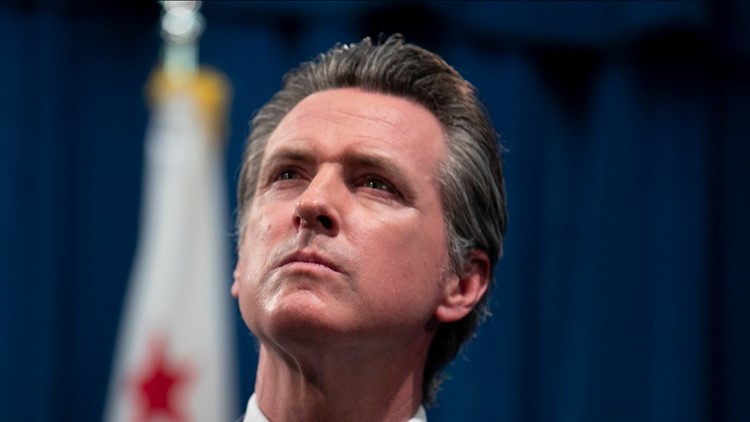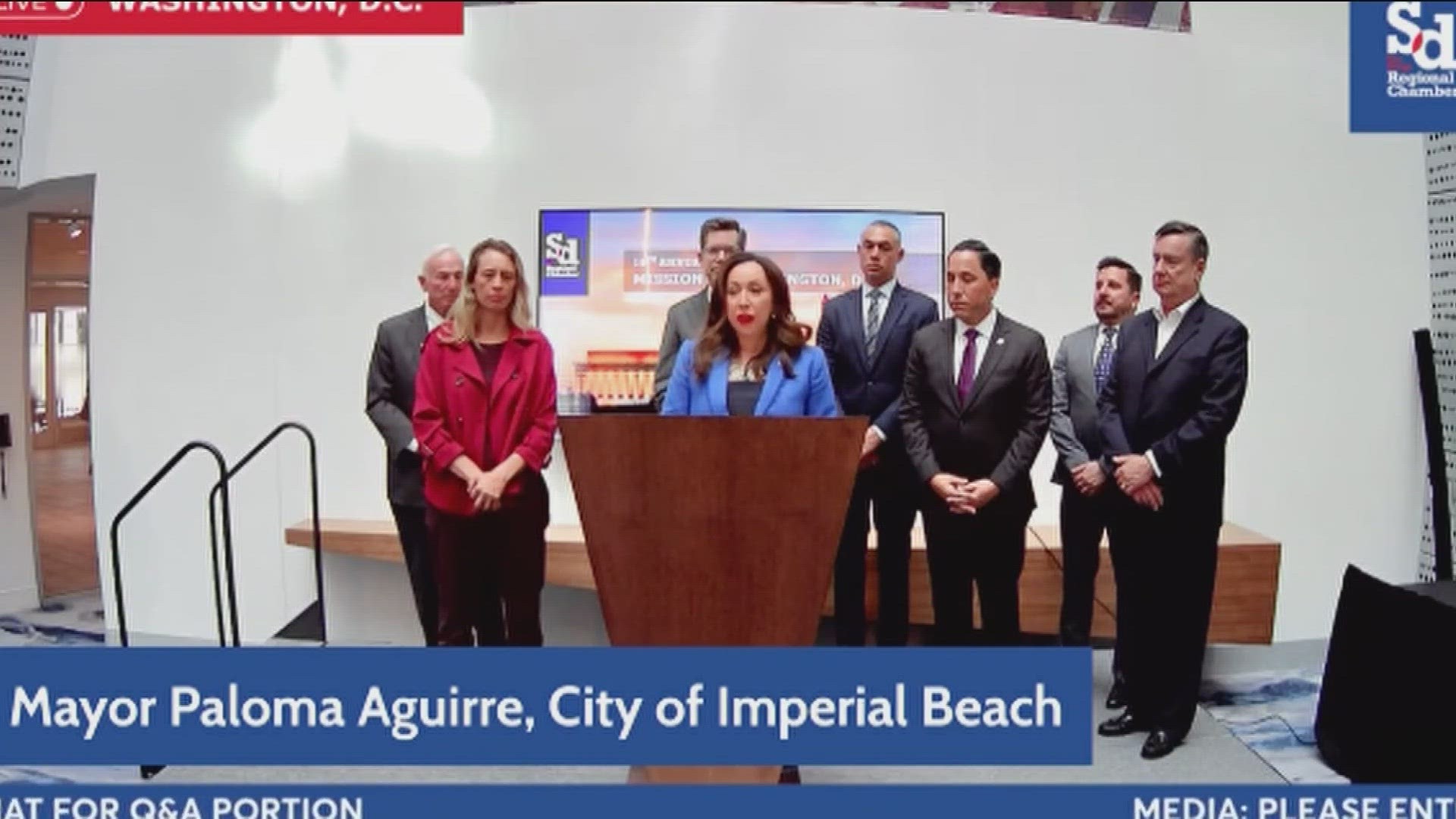SAN DIEGO — Speaking to the camera from his home office during the final days of a family quarantine, Gov. Gavin Newsom seemed at times to be giving himself a pep talk, as much as encouraging 40 million Californians to hunker down amid a coronavirus spike threatening to overwhelm hospitals.
“We will get through this,” the governor said last week, before a bookcase decorated with antique cameras and stylish knick-knacks. “This is the final surge. We have a light at the end of the tunnel with these vaccines, but we need to take seriously this moment.”
The moment is consequential not only for California — with more than 10,500 people hospitalized with COVID and 77% of the state’s population on the strictest state-ordered lockdown since spring — but also for Newsom’s political career. He’s approaching the midpoint of his four-year term just as California confronts a critical phase of the pandemic. How he manages it will shape his political future.
The second half of a governor’s first term is key to re-election prospects, and Newsom heads into it next month following a high-profile gaffe and facing huge challenges. Millions of Californians have lost their jobs and many struggled to get unemployment payments from a state agency plagued by problems, including accusations that it paid at least $1 billion to crime rings involving prison inmates. Most schools remain shuttered, leaving millions of students at home with online lessons that most parents say are ineffective. Two million Californians are at risk of being evicted after falling behind on rent during the pandemic, and more than 150,000 are homeless.
“If Gavin Newsom is able to rise to the occasion and get through the next year, that will say a lot about how voters see him in two years,” said Roger Salazar, a Democratic political consultant who worked for recalled former Gov. Gray Davis.
“How he gets through the pandemic, restarting the economy and putting behind these missteps — whether the personal one like the French Laundry (dinner party), or institutional ones like EDD. He’s got to be able to say ‘I came, I saw, I solved it.’”
Newsom’s solutions so far have not kept up with the scale of the problems. Weeks after his “strike team” recommended fixes for the Employment Development Department, the explosive fraud allegations prompted him to announce a new “task force.” Newsom has kicked the politically charged issue of school reopenings to local school boards, rebuffing pleas from mayors and state legislators to pressure districts to reopen. Though the state’s in the process of acquiring more than 6,100 motel rooms to house homeless people, tent encampments remain visible in many cities, and could grow with looming evictions.
But at his midpoint he’s also doing some rebooting, naming new leaders for the health and employment departments. He appears poised to bring on a new chief of staff with strong political chops, a sign that Newsom is looking ahead to reelection. Jim Deboo, a lobbyist and campaign consultant who has been a political adviser to Newsom, is joining the governor’s office in January. Current chief of staff Ann O’Leary — a respected policy wonk who lacked relationships in the statehouse — is widely expected to land a job in the administration of President-elect Joe Biden.
The incoming Biden administration could help Newsom, too. Not only will fellow Democrats run the federal government, but Californians will hold key positions, with Kamala Harris as vice president and Xavier Becerra nominated to Biden’s cabinet as health and human services secretary.
Newsom’s relationships in Washington could prove critical as he confronts the most important task of 2021: distributing the COVID vaccine so that Californians can get their lives back to normal. Because eventually, “everything in life will be pre-pandemic and post-pandemic,” said Fernando Guerra, a political science professor at Loyola Marymount University.
“His legacy is going to be the pandemic,” Guerra said. “It will always be: He was governor in the largest state during the pandemic. How did he do? What did he do? How did it work out?”
Waiting in the wings is Republican Kevin Faulconer, the outgoing mayor of San Diego. Faulconer said he is considering a run for governor in 2022 because California needs “a competition of ideas” after a decade of being run entirely by Democrats.
“One-party rule has been failing,” Faulconer said in an interview.
He’s especially critical of Newsom’s pandemic restrictions on businesses — saying, “every two weeks we get another set of rules and regulations” — and hands-off approach to school reopenings.
“Reopening the schools requires state leadership, and we’re not getting it,” Faulconer said.
“What we are seeing now is a de facto two tier system of education in our state, where private schools are open again, and public schools are not.”
It’s an argument that could paint an especially vivid distinction between Newsom and Faulconer. Newsom’s children attend a private school in Sacramento that opened for in-person instruction when infection rates were low this fall. Faulconer’s children attend a public college and a public high school that have moved entirely online.
Of course, it’s highly unlikely that a Republican could win election statewide, with Democrats holding a 22-point registration advantage. President Donald Trump is deeply unpopular in California; Faulconer voted for Trump, saying he thought he was better for the economy.
Californians are pessimistic about the economic outlook over the next year, with 58% of likely voters saying they expect periods of widespread unemployment or depression in a new survey by the Public Policy Institute of California.
Yet the poll suggests — perhaps counterintuitively — that Californians are largely satisfied with Newsom: 59% of likely voters said they approve of how he is handling the economy. The poll was taken before the latest stay-at-home orders took effect. News of Newsom’s dinner party at the French Laundry broke while the survey was being taken in November, but the sample size was too small for pollsters to discern if the incident had an impact on public opinion.
The results are in line with an October poll that found 58% of Californians approve of Newsom’s job performance and 61% approve of his handling of the coronavirus pandemic. That may say less about how Californians feel about Newsom overall than how they feel about him compared with Trump, said Mark Baldasarre, the institute’s president.
“The electorate is so polarized right now that people make their decisions about who they trust, who they like, and they tend to stick with that,” he said.
Californians overwhelmingly vote Democratic and feel the country is going in the wrong direction under Trump, so “they put their hope and support behind their Democratic governor,” Baldasarre said.
When Biden takes over, Californians may judge Newsom differently, he said, because they could expect more progress from a Democratic governor working with a federal administration of the same party.
“I think there will be more holding the governor accountable for what happens,” Baldasarre said, “Rather than: ‘How good a job are we doing at playing defense?’”



